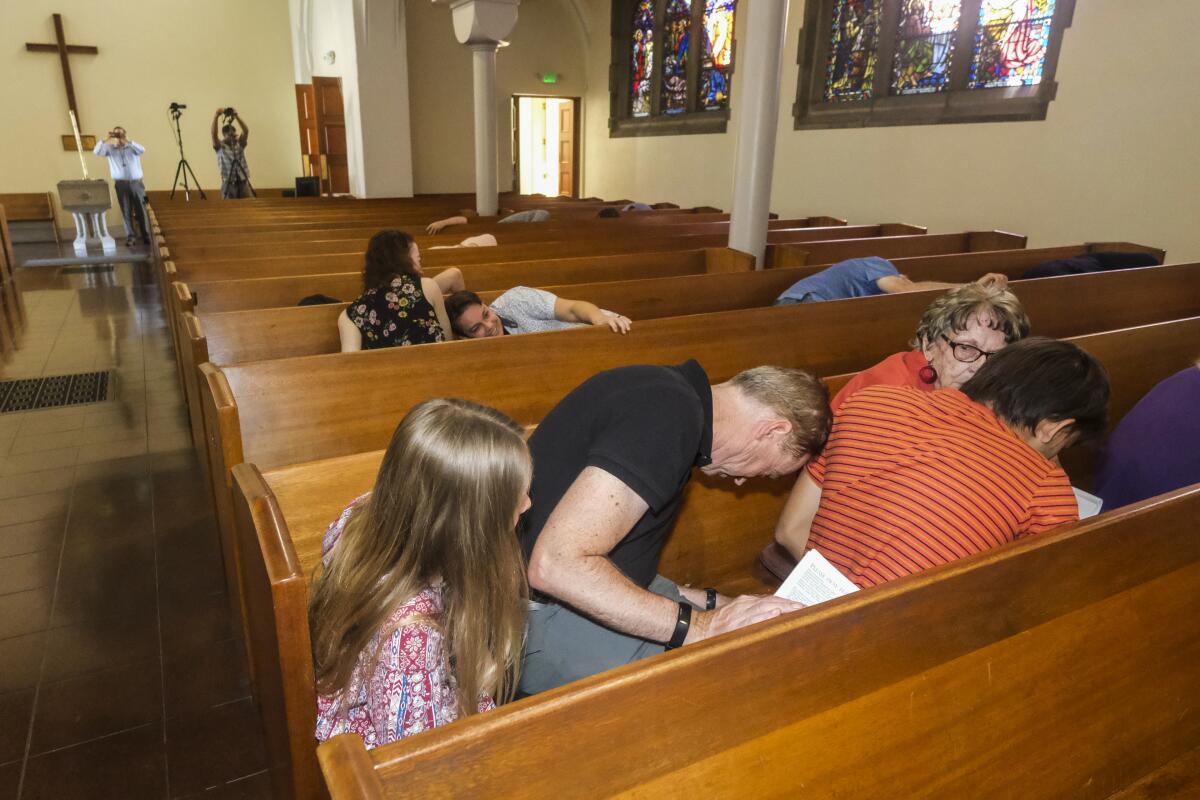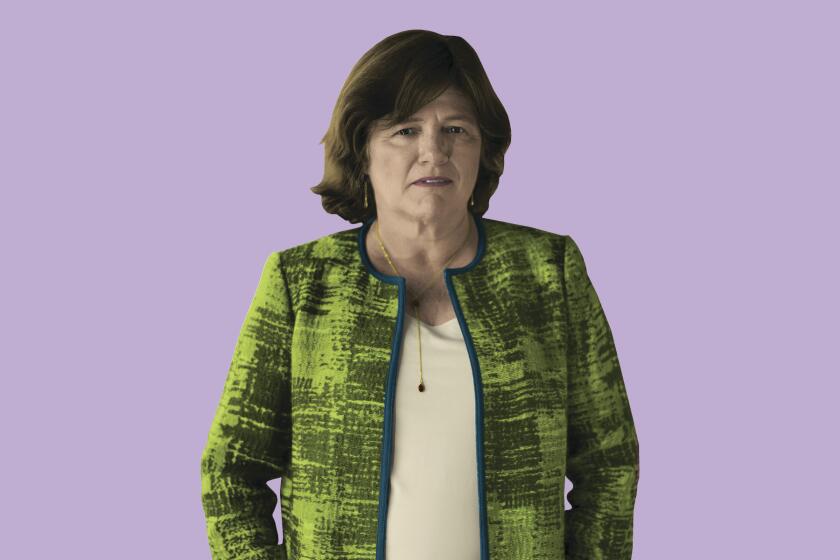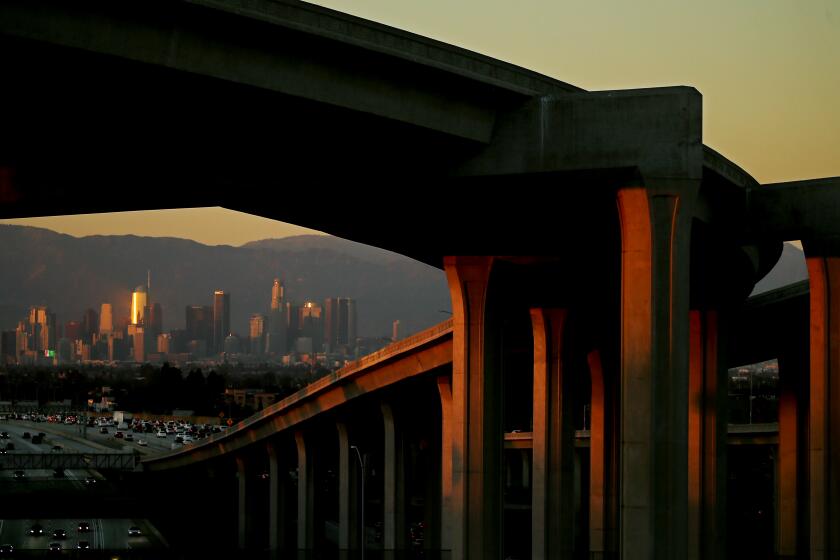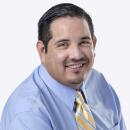Parishioners bow heads, drop, cover and hold on. Churches could be key for quake survival, expert says

- Share via
Text messages began to circulate about five minutes after an earthquake warning sounded for celebrants at St. James’ Episcopal Church in South Pasadena on Sunday morning.
About 80 congregants, clergy and choir members lay in the pews and covered their heads as a simulated earthquake hit the sanctuary. After about 20 seconds, parishioners rose and exited the church, heading to a designated meeting spot in the adjacent open parking lot.
Most church members texted designated cohort leaders, letting them know they were safe and outside the building.
Some parishioners did not respond, though. And others who gathered in the parking lot stood directly in the path of a telephone pole and overhead power lines, which could have caused severe bodily harm had Sunday’s drill been a powerful earthquake.
Seismologist Lucy Jones, California’s earthquake expert and the chief architect of Sunday’s drill, took note of the final tally. Six of seven cohorts responded that their parishioners were safe and no one was hurt or lost.
“Actually, this worked out better than I thought it would,” Jones, a parishioner at St. James’, said through a laugh. “I thought we were going to be having a comedy of errors, to be honest, and this was a nice surprise.”
St. James was one of six Episcopal parishes, out of the 135 that make up the Los Angeles Diocese, to take part in Sunday’s disaster resiliency event. Drills also took place at All Saints of Riverside, St. Andrew’s in Irvine, St. Edmund’s in San Marino, St. Luke’s in Monrovia and St. Peter’s in San Pedro.
Churches, temples, mosques and other faith-based institutions could serve as key places to help communities prepare for natural disasters, Jones contends.

In 2016, after more than 30 years with the U.S. Geological Survey, Jones launched the Dr. Lucy Jones Center for Science and Society, and she’s created a Connected Communities Resilience Program intended to help community- and faith-based organizations as well as local governments and nonprofits create a community-resiliency action plan to prepare for earthquakes or other disasters.
In a program established for the Episcopal Diocese of Los Angeles, churches are called on to understand the risk their parishioners face — whether from earthquakes, extreme heat, flooding or wildfires — and then create a disaster-resilience program.
“When we talk about earthquake preparedness, that gets everyone’s attention,” Jones said. “But it’s also about preparing and becoming resilient for other disasters that also happen.”
Potential steps in these preparedness plans could include reducing earthquake vulnerability in the church as well as members’ homes, stocking emergency supplies of water and food or creating a cooling center for intense heat waves. Churches may also decide to organize parishioners into groups who are assigned to text mobility-impaired parishioners to see whether they need help.
Other action items could include having the church’s building evaluated for structural safety and securing bookshelves and electronics to walls.
Jones classified the fight to stop climate change as a “moral imperative” but also said it was necessary to understand that “facing more disasters” is unavoidable.
The best way for communities to survive is to “shorten what is needed for recovery” after a disaster, she said.
The two methods to accomplish that are mitigation — checking retrofitting and evaluating flood risks, for example — and building community bonds. With the latter, Jones said that communities that share resources and stay in communication have a better chance of recovering.
People are much more important than kits. People will help each other when the power is out or they are thirsty. And people will help a community rebuild and keep Southern California a place we all want to live after a major quake.
The Rev. Melissa McCarthy, canon to the ordinary of the Diocese of Los Angeles, emphasized that proximity is not always an advantage in community building.
The diocese’s first cohort includes three San Gabriel Valley parishes within minutes of one another, along with churches in Irvine, Riverside and San Pedro.
She said an earthquake centered in the San Gabriel Valley would probably leave the three neighboring parishes in need, while the damage would be less severe in other areas.
“In that instance,” she said, “a parish like the one in Irvine could come through with aid and vice versa if there was a fire in Irvine, which has happened before.”
The potential for earthquake damage is a non-theoretical pursuit at St. James’. In 1987, the Whittier Narrows’ magnitude 5.9 thrust fault earthquake rocked the church on Oct. 1 while a 5.3 aftershock struck three days later.
St. James’ 75-foot bell tower was scarred with fissures, popping bricks and pieces of cornice. While the church and bell tower underwent repairs, the structures were also earthquake-retrofitted.
“Some of the tower had collapsed, and plaster covered everything inside the church,” said 92-year-old Jan Arenz, who was a congregant at St. James’ in 1987. “For two years, we met in the parish hall, so earthquake safety is wonderful and necessary.”
Arenz admitted she didn’t “entirely lie down” on the pew, leaving her feet still on the ground because the position wasn’t entirely comfortable.
In a report, L.A. City Controller Kenneth Mejia said L.A.’s climate plan lacks specifics and offers little in the way of meaningful metrics.
When Jones announced an earthquake was happening, 81-year-old Pasadena resident Judy Barbatoe immediately covered her head.
The retiree, who uses a wheelchair, hoped to avoid hypothetical falling ceiling plaster.
At that moment, Barbatoe became aware of all the dangers and shortcomings of her surroundings: nearby hanging chandeliers and stained-glass windows along with exits that are not wheelchair-accessible.
“Sometimes you need events like these,” she said, “to realize all the dangers around you and how best to get ready.”
Sunday’s earthquake drill comes days before the annual Shakeout. At 10:19 a.m. Thursday, people across California and other states will drop, cover and hold on — the best advice for dealing with shaking during an earthquake.
Officials encourage residents to download MyShake, the free earthquake early-warning app available on iOS and Android and developed by UC Berkeley. MyShake will be sending out a test drill alert during the ShakeOut drill Thursday.
More to Read
Sign up for Essential California
The most important California stories and recommendations in your inbox every morning.
You may occasionally receive promotional content from the Los Angeles Times.

















